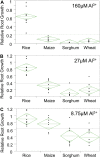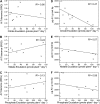Development of a novel aluminum tolerance phenotyping platform used for comparisons of cereal aluminum tolerance and investigations into rice aluminum tolerance mechanisms
- PMID: 20538888
- PMCID: PMC2923895
- DOI: 10.1104/pp.110.156794
Development of a novel aluminum tolerance phenotyping platform used for comparisons of cereal aluminum tolerance and investigations into rice aluminum tolerance mechanisms
Abstract
The genetic and physiological mechanisms of aluminum (Al) tolerance have been well studied in certain cereal crops, and Al tolerance genes have been identified in sorghum (Sorghum bicolor) and wheat (Triticum aestivum). Rice (Oryza sativa) has been reported to be highly Al tolerant; however, a direct comparison of rice and other cereals has not been reported, and the mechanisms of rice Al tolerance are poorly understood. To facilitate Al tolerance phenotyping in rice, a high-throughput imaging system and root quantification computer program was developed, permitting quantification of the entire root system, rather than just the longest root. Additionally, a novel hydroponic solution was developed and optimized for Al tolerance screening in rice and compared with the Yoshida's rice solution commonly used for rice Al tolerance studies. To gain a better understanding of Al tolerance in cereals, comparisons of Al tolerance across cereal species were conducted at four Al concentrations using seven to nine genetically diverse genotypes of wheat, maize (Zea mays), sorghum, and rice. Rice was significantly more tolerant than maize, wheat, and sorghum at all Al concentrations, with the mean Al tolerance level for rice found to be 2- to 6-fold greater than that in maize, wheat, and sorghum. Physiological experiments were conducted on a genetically diverse panel of more than 20 rice genotypes spanning the range of rice Al tolerance and compared with two maize genotypes to determine if rice utilizes the well-described Al tolerance mechanism of root tip Al exclusion mediated by organic acid exudation. These results clearly demonstrate that the extremely high levels of rice Al tolerance are mediated by a novel mechanism, which is independent of root tip Al exclusion.
Figures







References
-
- Brichkova GG, Shishlova AM, Maneshina TV, Kartel’ NA. (2007) The tolerance of tobacco genetically modified plants to aluminium. Tsitol Genet 41: 23–28 - PubMed
-
- Bushamuka V, Zobel R. (1998) Tap, basal, and lateral root responses to a stratified acid, aluminum-toxic soil. Crop Sci 38: 416–421
-
- Caniato FF, Guimaraes CT, Schaffert RE, Alves VM, Kochian LV, Borem A, Klein PE, Magalhaes JV. (2007) Genetic diversity for aluminum tolerance in sorghum. Theor Appl Genet 114: 863–876 - PubMed
-
- Champoux MC, Wang G, Sarkarung S, Mackill DJ, O'Toole JC, Huang N, McCouch S. (1995) Locating genes associated with root morphology and drought avoidance in rice via linkage to molecular markers. Theor Appl Genet 90: 969–981 - PubMed
Publication types
MeSH terms
Substances
LinkOut - more resources
Full Text Sources

